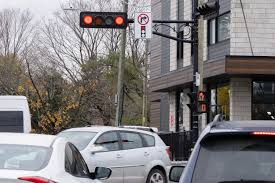In cities across the United States, a debate is brewing over an age-old traffic policy: the “Right on Red” rule. Instituted in the 1970s as a measure to save fuel during the energy crisis, this rule permits drivers to turn right at a red light after coming to a complete stop, provided no pedestrians or vehicles are in their path. While this measure has become a convenience for drivers, pedestrian safety advocates argue it poses significant risks to those on foot.
With more urban areas aiming to prioritize pedestrian-friendly environments, the battle over whether to keep or eliminate the rule has intensified. This controversy pits the rights of walkers against the convenience of drivers, forcing policymakers to navigate a delicate balancing act.
The Origins of Right on Red
The “Right on Red” rule was widely adopted in the U.S. during the 1970s, driven by the federal government’s push to conserve energy in the wake of the oil embargo. According to the U.S. Department of Energy, turning right at red lights reduces idling time for vehicles, thereby saving fuel and reducing emissions. The policy quickly gained traction, becoming a standard feature of traffic laws in most states.
However, urban landscapes today differ significantly from those of the 1970s. With increasing numbers of pedestrians, cyclists, and e-scooters sharing the streets, critics argue that the rule is outdated and does not reflect the realities of modern transportation dynamics.
The Risks for Pedestrians
Pedestrian fatalities in the U.S. have surged in recent years. According to the National Highway Traffic Safety Administration (NHTSA), pedestrian deaths accounted for 17% of all traffic-related fatalities in 2022, marking a 13% increase compared to the previous decade.
Traffic safety experts attribute part of this rise to the “Right on Red” rule. Drivers often fail to come to a complete stop before turning or neglect to check for pedestrians in crosswalks. Additionally, pedestrians crossing with a walk signal may find themselves in conflict with turning vehicles, creating hazardous situations.
“Drivers are conditioned to look left for oncoming traffic but often forget to look right for pedestrians,” explains Erin Miller, a transportation safety advocate. “This small oversight can have devastating consequences.”
The Push for Change
Cities like New York, Washington, D.C., and San Francisco are leading the charge to limit or ban the “Right on Red” rule. For instance, New York City’s Vision Zero program, launched in 2014, aims to eliminate traffic deaths and serious injuries through measures such as banning right turns at red lights in high-risk areas. Advocates argue that such policies prioritize pedestrian safety without significantly inconveniencing drivers.
“Pedestrian safety is paramount in urban areas,” says Sarah Henderson, a policy analyst with Vision Zero. “We’ve found that restricting ‘Right on Red’ in busy intersections can greatly reduce near-miss incidents and accidents.”
Counterarguments: Driver Convenience
While safety advocates push for change, many drivers and transportation experts argue that banning “Right on Red” could lead to increased traffic congestion and frustration. In sprawling cities with limited public transportation infrastructure, driving remains the primary mode of transportation for many residents.
According to a report by the Federal Highway Administration (FHWA), prohibiting right turns on red lights could extend commute times, especially during peak hours. Some critics also question whether banning the rule will have a measurable impact on pedestrian safety, noting that poor road design and distracted driving contribute more significantly to accidents.
“While pedestrian safety is crucial, we need to balance this with practical solutions for drivers,” says Mark Rivera, a traffic engineer based in Los Angeles. “Banning ‘Right on Red’ altogether could create unintended consequences, like gridlock in already congested areas.”
Global Comparisons
The U.S. is not alone in grappling with this issue. In most European countries, turning on red is prohibited unless explicitly allowed by signage, with a strong emphasis on pedestrian safety in urban planning. According to data from the European Transport Safety Council, pedestrian fatalities are significantly lower in Europe compared to the U.S., a difference often attributed to stricter traffic laws and better infrastructure design.
“Cities like Amsterdam and Copenhagen demonstrate that prioritizing pedestrians and cyclists doesn’t just improve safety but also enhances the overall quality of urban life,” says Laura White, a transportation researcher. “It’s a model the U.S. could learn from.”
The Middle Ground
As the debate continues, some cities are experimenting with compromise solutions. For instance, Seattle has implemented “No Turn on Red” signs at high-risk intersections while maintaining the rule in less pedestrian-heavy areas. Similarly, Boston has introduced pedestrian-exclusive signal phases, during which all vehicular traffic is stopped to allow safe crossing.
These targeted approaches aim to address safety concerns without entirely sacrificing driver convenience. However, their success depends on consistent enforcement and public awareness campaigns to educate both drivers and pedestrians about the changes.
Conclusion
The clash between pedestrian safety and driver convenience highlights a larger issue: how cities adapt to evolving transportation needs. With pedestrian fatalities on the rise, it’s clear that current traffic policies require reevaluation. However, finding a solution that balances safety and efficiency will require collaboration among city planners, traffic engineers, and community stakeholders.
As urban centers grow and strive to become more pedestrian-friendly, the future of “Right on Red” will likely depend on data-driven policies that prioritize safety without unduly burdening drivers. Until then, the debate will remain a focal point in discussions about the evolution of urban mobility.
Disclaimer – Our team has carefully fact-checked this article to make sure it’s accurate and free from any misinformation. We’re dedicated to keeping our content honest and reliable for our readers.








